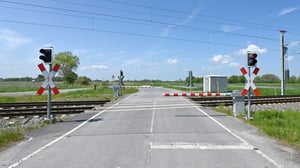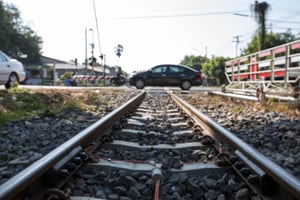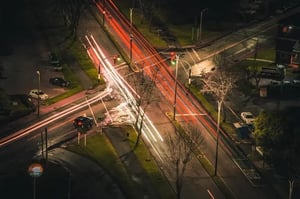
Railroad Crossing Safety
The Fusion Sensor: Turning Railroad Data Into Safer Tracks
Crossing railroad tracks is part of everyday travel in many communities, but it can be dangerous without the right systems in place. The U.S. has over 140,000 miles of rail lines and 212,000 highway-grade crossings. In these areas, reliable safety tools aren’t just helpful—they’re essential to protecting drivers, cyclists, and pedestrians.
In 2024, collisions and trespassing incidents at rail crossings led to 818 deaths and 646 injuries across the country. These numbers point to critical gaps where faster alerts and better monitoring could save lives and make our roads safer.
Omnisight’s Fusion Sensor provides real-time data and alerts, empowering cities to monitor rail crossings more effectively, respond to incidents faster, and improve coordination between road and rail systems.

Main Safety Risks of Railroad Crossings
Improving railroad crossing safety starts with identifying the most common and preventable dangers. While trains follow strict protocols, the highest risk often comes from drivers approaching a railroad crossing at unsafe times.
Below are some common issues that contribute to rail-related accidents and fatalities:
Trespassing Pedestrians
The Federal Railroad Administration (FRA) identifies trespassing as the leading cause of rail-related deaths in the U.S., accounting for more than 500 fatalities each year.
These tragic incidents often involve pedestrians crossing at unauthorized spots, misjudging a train’s speed, or entering rail areas while distracted.
Reckless Drivers
According to the FRA, highway-grade crossing accidents are the second leading cause of rail-related deaths in the U.S. More than 200 lives are lost each year in these incidents, often due to risky driving choices. Some drivers attempt to beat an oncoming train or misjudge the timing, only to become trapped on the tracks.
Poor Visibility
Limited visibility plays a major role in many railroad crossing accidents. Overgrown vegetation, buildings, or parked vehicles can obstruct a driver’s view of approaching trains. When sightlines are blocked, gauging a train’s speed or distance becomes harder, sometimes resulting in poor decisions and dangerous crossings.
Traffic-related Risks
Railroad crossings often experience constant vehicle traffic in busy urban areas or near complicated intersections. When congestion builds or intersections become blocked, drivers can get trapped on the tracks with no clear path forward. These high-risk scenarios call for more responsive traffic management to prevent collisions.

How the Fusion Sensor Supports Railroad Crossing Safety Measures
Advanced traffic management tools like the Omnisight Fusion Sensor improve railroad crossing safety by delivering live data when needed.
Here’s how the Fusion Sensor works, and why it makes a difference for railroad safety:
- Adaptive signal control at crossings. The Fusion Sensor uses HD3D radar paired with a high-definition video camera to detect oncoming trains and trigger Adaptive Signal Timing (AST). This system allows nearby traffic lights to adjust in real time, ensuring vehicles have enough time to clear the tracks before the train arrives.
- Accurate object recognition. The Omnisight Fusion Sensor uses AI-powered video to identify and classify objects on railways with 98.7% accuracy. It can differentiate between vehicles, pedestrians, and debris, instantly detecting issues like trespassing or stalled cars, so local responders can act quickly before an incident occurs.
- Long-term risk mitigation. The Fusion Sensor provides detailed insights into high-risk behaviors, like where pedestrians cross unsafely, when drivers run signals, and how traffic flows during peak hours. This helps cities identify and address recurring hazards before they lead to another accident.
- Quick to install and easy to maintain. Designed for flexible deployment, the Fusion Sensor adapts easily to single crossings and widespread networks. Each unit runs on just 20 watts and uses a standard barrel jack for easy installation and power, making it simple to scale coverage and collect consistent data citywide.
-1.png?width=300&name=Fusion%20Sensor%20White%20(1)-1.png)
Benefits of Advanced Rail Safety Technologies
The Fusion Sensor is designed to support your city’s railroad crossing safety equipment. It improves your community’s traffic coordination, enables quicker incident response, and reduces risks at crossings—all while supporting more forward-thinking infrastructure planning.
- Reduced trespassing incidents. With Fusion Sensors installed at all rail crossings, local emergency services receive instant alerts about trespassing pedestrians. This allows for faster responses and helps prevent accidents.
- Fewer track obstructions and collisions. When a vehicle gets stuck on the tracks, every second counts. The Fusion Sensor detects the obstruction and alerts traffic management teams, giving them time to act and clear the tracks before a collision happens.
- Reliable performance in any weather. Whether it’s rain, fog, or darkness, the Fusion Sensor delivers consistent, accurate detection in all conditions, helping to reduce incident rates and keep crossings safe year-round.
-1.png?width=300&name=Fusion%20Sensor%20White%20(1)-1.png)
Make Railroad Crossings Safer With Omnisight
Every community, from small towns to major cities, needs reliable solutions to reduce risks at rail crossings. The Fusion Sensor gives your city the real-time data and fast, accurate incident detection capabilities it needs to prevent railway crossing injuries and fatalities.
Make your city safer for everyone, including at railway crossings. Contact Omnisight to see how the Fusion Sensor can support your rail safety goals.

